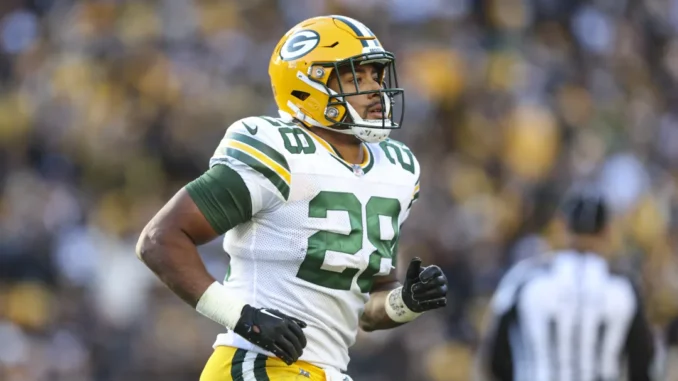
The Green Bay Packers have significantly bolstered their backfield, now considered one of the deepest and most talented in the NFL, with the addition of star running back Josh Jacobs and rookie MarShawn Lloyd. This newfound depth raises intriguing questions about the role of AJ Dillon, who has been a key player for the Packers.
Josh Jacobs is set to lead the Packers’ rushing attack, with MarShawn Lloyd expected to see substantial playing time early in his career. This development prompts speculation on how Dillon, previously the team’s No. 2 running back, will be utilized. Dillon’s unique skill set gives head coach Matt LaFleur the flexibility to deploy him in varied and potentially innovative ways.
Despite the depth chart shake-up, the Packers retained Dillon with a rare four-year qualifying offer, a deal that is notably team-friendly. This move suggests that LaFleur has specific plans for Dillon, which might involve a shift in his role within the offense.
In March, LaFleur hinted at Dillon’s potential new responsibilities, praising his versatility and suggesting he could be used as a “moveable piece” rather than just a traditional tailback. This statement left many wondering about Dillon’s future contributions.
Running backs coach Ben Sirmans provided additional insights, particularly in light of Josiah Deguara’s departure, which created a vacancy in the H-back role within LaFleur’s offense. Fullback Henry Pearson and tight end Ben Sims are considered potential candidates to fill this gap, but Dillon’s name has also been brought into the conversation.
Sirmans highlighted Dillon’s capabilities, particularly his ability to break tackles and catch passes out of the backfield, which would allow LaFleur to implement creative offensive strategies. Dillon’s proficiency in pass protection further supports the idea of expanding his role. However, the critical question remains whether Dillon can handle the lead-blocking duties essential for the H-back position. His performance over the past four seasons will be scrutinized to determine if he can outshine Pearson or Sims in this capacity.
Given the Packers’ crowded backfield, Dillon’s opportunities for consistent double-digit carries have diminished, especially after drafting Lloyd. Jacobs and Lloyd are expected to handle the bulk of the carries, with the team also having high expectations for second-year player Emanuel Wilson.
LaFleur’s vision for Dillon could involve utilizing him in ways that maximize his strengths, potentially transforming him into a versatile H-back. This role would capitalize on Dillon’s running and receiving abilities, offering various offensive possibilities. However, the success of this transition hinges on Dillon’s effectiveness as a blocker, a significant “if” that will need to be addressed through training and game performance.
Ultimately, if Dillon can adapt to and thrive in the H-back role, it could significantly enhance the Packers’ offensive flexibility and effectiveness. His ability to fulfill these new responsibilities will be closely monitored as the team prepares for the 2024 season.
Leave a Reply